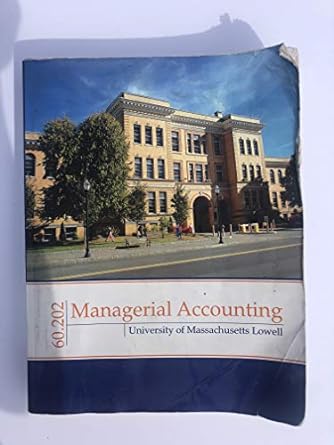Question
please help me.. i have the answer but I want you to paraphrase these answers , use your own words , I don't want to
please help me.. i have the answer but I want you to paraphrase these answers, use your own words, I don't want to copy and paste please. Thank you ..
Q1. On your own words, outline the accounting principles and assumptions and explain each one.
- Influence: Effective management accounting starts and ends with discussions, enabling management to break through blockages that prevent getting everyone on the same page, and build a road to integrated thought. Effective communication offers better and simpler perspectives, in this regard, to influence the decision-making process.
- Relevance: Management accounting principles provide valuable relevant inputs to the companys policy and decision makers as and when required on a routine timely basis. This principle details about the various guidelines regarding how the past and current information (both financial and non-financial) in the form of socio-economic and environmental data retrieved from internal and external sources are detected.
- Analysis: The effect on value is analysed. This theory allows organizations to model various situations to understand their effect on value creation and preservation. This concept requires a detailed understanding of the business model and the macro-economic atmosphere. Good management accounting functions can turn knowledge into insight by analyzing the effect of the situations being considered.
- Trust: Transparency and accountability make the decision-making system more trustworthy. Balancing short-term economic interests against long-term stakeholder value strengthens reputation and peoples confidence in the organization.
-------
Q2. What is the accounting cycle? Explain every step starting from analyzing transactions to preparing post-closing trial balance.
The Accounting Cycle is a method for determining, recording and summarizing the financial transactions of the company with the goal of obtaining valuable information in the form of three financial statements namely the Balance Sheet, Income Statement, and Cash Flows. The accounting cycle is a holistic method of tracking and documenting all of the organization's financial transactions, from the moment the transaction takes place, to its appearance on the financial statements, to the closure of the accounts. It begins with an accounting transaction and ends when the books of the accounts are closed.
Analysis of transactions and collection of data:
- The company's accountant gathers data and analyzes transactions.
- The accountant must analyze each transaction, figure out the causes, place it in the appropriate accounts, and then evaluate it.
Journalizing:
- The transactions are recorded in the first books of the accounts.
- Each transaction is transferred to the General Journal; and for each entry, a description is written to show the purpose behind the debiting or crediting of each account.
- Journalizing and verifying is vital, because any mistake at this point of reporting will lead to cascading effect subsequently.
Recording the journals into the ledger accounts:
- Posting is required to provide a full record of all accounting transactions in the general ledger used to produce the company's financial statements.
Preparing an unadjusted trial balance:
- The unadjusted trial balance is generated from the closing balances of the general ledger accounts.
- Then, the sum of the entries on the debit side and the credit side are determined and checked whether or not the two sides have identical balances.
Performing adjusting entries:
- The modification entries are prepared in this phase. Adjusting entries are journal entries recorded at the end of the accounting period that change the final balances of different general accounts.
- Such changes are made to match the published results more closely with the actual financial situation of the company.
Creating adjusted trial balance:
- Modified trial balance is prepared after passing the changing entries.
- The final outcome of this modified trial balance thus shows the impact of all financial incidents which happened during that particular reporting period.
- The trial balance is called the adjusted trial balance because it is updated after the adjustment entries have been completed and, as a result, the trial balance will be used to prepare the most relevant financial statements.
Creating financial statements:
- Financial statements can be compiled directly from the adjusted trial balance.
- The most important financial statements compiled using the adjusted trial balance are the Income Statement, Balance Sheet and Cash Flow Statement.
Closing the books:
- Closing the books means that all financial statements are prepared and all transactions are reported, reviewed, listed and documented.
- After closing the accounts, a new accounting period would begin and the accountant would have to start doing the above steps again.
Creating a post-closing trial balance:
- In order to ensure that the accounting transactions are correctly reported, reviewed and summarized, a post-closure trial balance is prepared.
- The credit side and the debit side are compared to see whether everything is in the right order or not.
Completing the above measures would complete the company's accounting cycle and make it available for the next fiscal period.
Step by Step Solution
There are 3 Steps involved in it
Step: 1

Get Instant Access to Expert-Tailored Solutions
See step-by-step solutions with expert insights and AI powered tools for academic success
Step: 2

Step: 3

Ace Your Homework with AI
Get the answers you need in no time with our AI-driven, step-by-step assistance
Get Started


